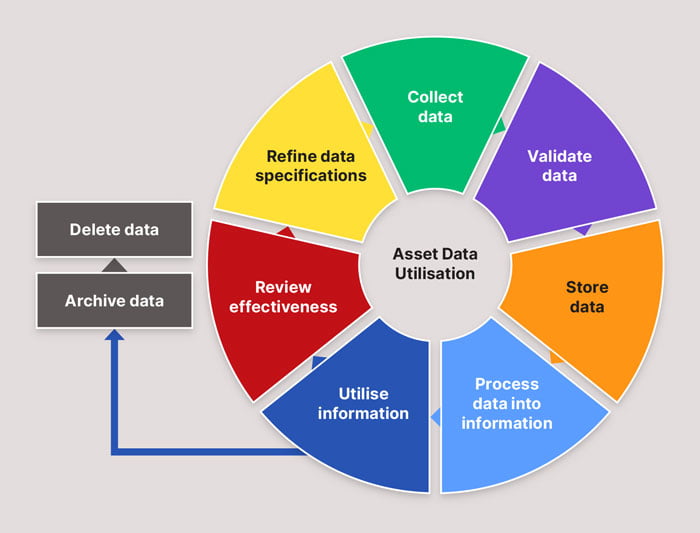A vital element of effective Asset Management is decision-making that is evidence-based and data-driven. In addition, sufficient, accurate data and documentation must be collected in order to:
- Meet legal and statutory requirements, and
- Permit effective communication with stakeholders
In this article, the 11th in our series on Implementing ISO 55000, we will discuss these elements in the context of ISO 55001.
Articles in this series
Data, information, knowledge and wisdom
The common definition of the term “data” is that is represents unorganised and unprocessed facts, and is usually static in nature. However, for us to be able to make decisions using that data, it first needs to be processed and organised into “information”. Information usually has some meaning or purpose, and has typically been processed with a particular aim or objective in mind (e.g. to be used to make a decision). Decisions are then made using that information by people who have “knowledge”. Knowledge is the interpretation of information using human understanding based on study and experience. Data is not information, and information is not knowledge. Rather, information is derived from data, and knowledge is derived from information. Finally, we could also define the term “wisdom”, which combines knowledge with experience and judgement, and which allows us to better understand what knowledge, information and data we need in order to be able to make an effective decision [1]. All of this can be visualised as shown in the WKID pyramid below.

ISO 55001 requirements regarding asset management data
The requirements contained within ISO 55001 regarding Asset Management Data are fairly general and high level. At face value, they seem deceptively simple.
Essentially, ISO 55001 requires organisations to:
- Understand what their information needs are to meet the requirements of stakeholders (internal and external) regarding information and reporting (financial and non-financial). This, by definition, would include data and information required to meet any statutory or legal reporting and record-keeping obligations, including ensuring that traceability meets any legal and regulatory requirements.
- Understand what data and information is required in order to support the achievement of organisational and asset management objectives.
- In addressing the previous bullet point, consider the impact of quality, availability and management of information on decision making.
- Determine:
- What data is to be collected
- The level of quality of data collected
- How and when to collect the data
- How and when to analyse and evaluate the data collected.
- Have processes in place for the effective management of information.
- Have an effective document management system in place.
However, the devil is in the detail. When was the last time that the organisation you work for seriously considered what data it needs in order to make effective decisions? Are there adequate specifications in place which describe the quality of data required? And if there are, to what extent are these specifications adhered to?
Data as an asset
There is a comparatively strong case for considering data, information and knowledge within an organisation as assets in their own right. Certainly the ISO 55000 definition of an asset as being “something of potential value to an organisation” could well apply. And the similarities do not end there. It is also possible to consider that data and information and the systems that collect and process data and information have lifecycles, just as physical assets do. It could be visualised as shown below.

Of these elements of the data lifecycle, the most important aspect is the first – Identifying the Need, and we will discuss this element in more detail.
Specifying data and information needs
ISO 55001 clearly states that data and information should be collected in order to ensure that:
- stakeholders’ needs for information and reporting are met, and
- the organisation can meet its asset management and organisational objectives.
It therefore makes sense that these should be the starting points for determining what data and information you need, and for designing the systems and procedures for collecting, managing and analysing this data and information. This is, in essence, a top-down approach.
Most of the data collected will go towards making more effective asset management decisions. Accordingly, you should consider the types of asset management decisions that will be made and the comparative importance of those decisions in the context of achievement of the organisation’s Asset Management objectives.
Note that decisions can be made at many different organisational levels, including:
- Strategic Decisions – potentially those with the greatest potential business impact, but also those for which objective data is most likely to be difficult to obtain and analyse
- Management Decisions – such as those relating to the replacement or upgrading of assets to better meet business needs
- Operational Decisions – involved with short term control of maintenance and operational activities
The data to support these decisions can come from both within and outside the organisation, and both sources must typically be consulted to make informed decisions. Data from within the organisation may come from corporate Information Systems, from Operational Technology systems, or from neither of these.
For all the data being considered, it is not sufficient to just identify what is needed, ISO 55001 also requires you to assess:
- The quality required of the data collected
- How and when to collect the data
- How and when to analyse and evaluate the data collected
Data quality can be specified in terms of many attributes [2], including:
- Completeness (is all of the data to be collected, or only some of it)
- Accuracy (does the data accurately represent reality – particularly a concern when human data input is required)
- Timeliness (is the data available as and when required)
- Accessibility (is the data readily available to those using it)
- Consistency (are the same definitions and standards applied across the organisation)
So you can see that assessing and specifying an organisations’ data requirements is potentially vast and wide-ranging. The real question here, in terms of ISO 55001 alignment, is what level of detail is required in order to demonstrate that your organisation has adequately considered and identified its information requirements?
Specifying asset management data requirements – a pragmatic approach
In our view, taking a pragmatic approach, the answer lies, as is usual in all things related to Asset Management, by considering, for each decision and/or information or reporting requirement:
- The Benefits of better decision making/reporting
- The Risks associated with poor (non-data-driven) decision making or reporting, and
- The Costs associated with specifying, collecting, managing and analysing the data required for more effective decision-making and reporting.
To this end, we suggest that you start by:
- Identifying your most critical assets – this is a requirement in order to align with other parts of ISO 55001 in any case, so should not be an additional onerous task
- Identifying the requirements of all key stakeholders (including regulators and other external stakeholders) regarding the mandatory provision of reports or information
- Identifying the types of decisions that you will make which will have the greatest potential impact on the achievement of your asset management (and organisational) objectives. These decisions could include:
- Capital Investment Decisions
- Decisions regarding the allocation of Operating Expenditure
- Technical Decisions relating to day-to-day Operations
- Decisions regarding the timing of major events or activities such as shutdowns or overhauls
- Decisions regarding the allocation of Working Capital (such as for spare parts holdings)
- Decisions relating to whether to insource or outsource particular activities
- Etc.
For critical assets and critical decisions, you should carefully consider what information you need to have in order to make an effective decision, and therefore what data you require in order to be able to provide that information. The data that you may need could take many different forms including:
- Data about the assets themselves (what they are, what they cost to acquire, where they are located etc.)
- Data about the current condition of the assets
- Data about the current level of performance of the assets (in terms of technical performance and cost performance – operating and maintenance)
- Data relating to the activities that have been performed on the assets – operational activities, maintenance activities and modifications/upgrades/replacements
- Data about the financial or other impacts if the assets underperform or fail to perform at all
- Data relating to safety, environmental or other incidents associated with the assets
- Data relating to forecasts of future asset performance, costs and risks
- Other data that allows adequate evaluation of alternative courses of action
Clearly, the data that is required for more critical decisions and/or reports must be collected, evaluated and analysed with a high degree of quality and rigour. In an organisation with effective asset management decision making in place, we would expect to see that the organisation has:
- Consciously considered this issue,
- Identified the data required to support decision-making for critical decisions on critical assets,
- Identified the data required by stakeholders for reporting on critical assets, and
- Specified the quality standards for those data elements in terms of the attributes mentioned earlier in this article (Completeness, Accuracy, Timeliness, Accessibility and Consistency)
Managing and processing asset management data
Once data requirements have been specified, then processes and systems must be put in place for collecting, processing, utilising and managing that data. The key steps in this process can be visualised below.

Some notes on each of these steps include:
Collecting data
Some data may be collected without the need for human input – for example, asset performance or condition data may be able to be collected directly from the machine. It will be important to ensure, particularly for data that is obtained via human input, that the data collected complies with the relevant quality standards for that data. For example, when collecting data relating to new assets, it will be important to ensure that “as built” data is collected, not just “as designed” or “as approved for construction”.
Validating data
Given the issues associated with assuring the quality of data collected, frequently an additional step is required in order to ensure that the data collected does comply with the relevant quality standards, and that, if needed, adjustments are made to the collected data. For example, when collecting downtime data for key assets, if control room operators assign codes to this data to indicate the cause of the downtime, then these may need to be reviewed on a daily basis in order to ensure that the causes assigned by the control room operators accurately reflect reality.
Storing data
Data can be stored in a large number of ways in a large number of locations. While it is easy to focus on electronic storage within corporate information systems, data may also be stored in paper form (for example operator check sheets) and in systems outside the formal corporate systems, including Process Historian databases, as well as individual user’s spreadsheets and databases. In order to maintain the integrity of critical data, care should be taken to ensure that there is only “one source of truth” for all stored data – that duplicate and potentially contradictory values for the same data item do not exist.
Processing data into information
This is the sexy bit that gets all the attention and costs all the money. Suffice it to say that data, until such time as it is processed into meaningful information, is of limited or no value. Great care should be taken, therefore, to ensure that the functionality required of information processing systems (whether they be ERP systems, Reliability Modelling software or other optimisation algorithms) is properly defined, and that rigorous testing is performed to ensure that data is accurately translated into information that is meaningful for effective decision making.
Utilise information
If data that has not been processed into information has no value, then this is even more true for information that is not effectively utilised. In order to effectively utilise information, business processes associated with reporting and decision-making must require the relevant information to be used. Those utilising the information must understand its meaning and importance, and decisions made must be actually implemented. These requirements have less to do with the quality of the information (although obviously the information must be presented in a manner that enables its effective use), and more to do with business processes, accountabilities and competence.
Review effectiveness and refine data specifications
As part of a continuous improvement loop, organisations should periodically assess whether the information they are receiving is adequate to meet their requirements for effective decision making, and whether the results that are being achieved as a result of their decisions using this information are delivering the expected outcomes. This may lead to improvements in many elements of the data management system, including the specification of what data is to be collected, data quality specifications, information processing requirements and/or business processes and competences.
Archive and delete data
There should be formal processes in place for periodically either archiving or deleting data that is no longer required. This could include processes for summarising data (for example, consolidating minute-by-minute data into daily averages) prior to archiving. The key item to consider here is the likely need is for future access to this data. In some cases, there may be legal or other statutory requirements for data retention that may need to be complied with.
Record keeping and document management
One other area to consider when discussing data management is the requirement for appropriate record keeping and document management. There are a number of documents that are required by ISO 55001 to be developed and effectively controlled. These include:
- Asset Management Policy
- Asset Management Objectives
- Strategic Asset Management Plan
- Asset Management Plans
- Evidence of Asset Management Competence
- Evidence of the results of monitoring, measurement, analysis and evaluation of Asset performance and Asset Management system performance
- Evidence of implementation of recommendations from Asset Management audits
- Evidence that Management Reviews of the Asset Management system have taken place.
All of the usual document management controls should apply to these documents, including effective change control, revision tracking, access controls etc. However, in addition to the documents listed above, document management controls may need to be applied to a number of other documents that form part of your Asset Management system in order to ensure compliance and reduce overall business risks associated with non-compliance. This could include, for example, control over documented operating procedures, maintenance procedures etc. It will be important for you to identify those additional documents that should be controlled and make sure that the appropriate controls are in place.
A final word of caution
One final word of caution relating to Asset Management Data and Information Processing. An awful lot of organisations (and software vendors selling to those organisations) overestimate their organisation’s ability to capture and effectively utilise data and information. When it comes down to specifying and configuring information systems, it is very easy to get caught up in all of the possibilities that these technologies can provide. But just because you could, doesn’t mean you should.
There is a common view that electronic data storage is cheap and getting cheaper, and that therefore we should collect as much data as we can (particularly now we are talking about the possibilities of Big Data), even if we are not sure how we will use it yet. But the reality is that unless you apply appropriate quality standards to that data then all that you will end up with is a lot of unusable junk cluttering your corporate hard drives. Data storage may be cheap, but assuring data quality can be expensive in time and effort, so be careful to make sure that you think carefully before you decide what data you need to store. Some engineers are inveterate hoarders, never wanting to throw anything out because “it may come in handy one day” only to find that they can’t get into their workshop/shed/warehouse because it is piled high with rusting rubbish. Make sure you aren’t the same with data.
Along similar lines, most commercial software packages these days have capabilities that are far in advance of what organisations currently use. The business case for using these more advanced capabilities is often seductively attractive. But frequently we find that the organisational discipline and competences required to provide the required data to the quality standard required for effective use of these new capabilities is seriously lacking, and the effort required to enhance competence and implement the required level of discipline is far greater than expected. As a result, the capabilities are never fully implemented, the information systems are often filled with low quality, non-useable data, and considerable time and expense has been spent in inputting this data – a totally non-value-adding activity.
As previously mentioned – just because you could, doesn’t mean you should. Make sure that the decisions you make regarding data and information management are firmly grounded in a pragmatic view of how things work in the real world.
Looking for further training in ISO 55001 certification?
We offer a range of asset management courses, some of which specialise in ISO 55001 deliverables. If you are interested in reading more about our courses, you can do so by following the links below.
-
Product on sale
 Implementing an ISO 55001 Compliant Asset Management SystemOriginal price was: $2,275.00.$2,047.50Current price is: $2,047.50.
Implementing an ISO 55001 Compliant Asset Management SystemOriginal price was: $2,275.00.$2,047.50Current price is: $2,047.50. -
Product on sale
 Asset Management Foundation AwardOriginal price was: $1,195.00.$1,075.50Current price is: $1,075.50.
Asset Management Foundation AwardOriginal price was: $1,195.00.$1,075.50Current price is: $1,075.50.
[1] https://en.wikipedia.org/wiki/DIKW_Pyramid


